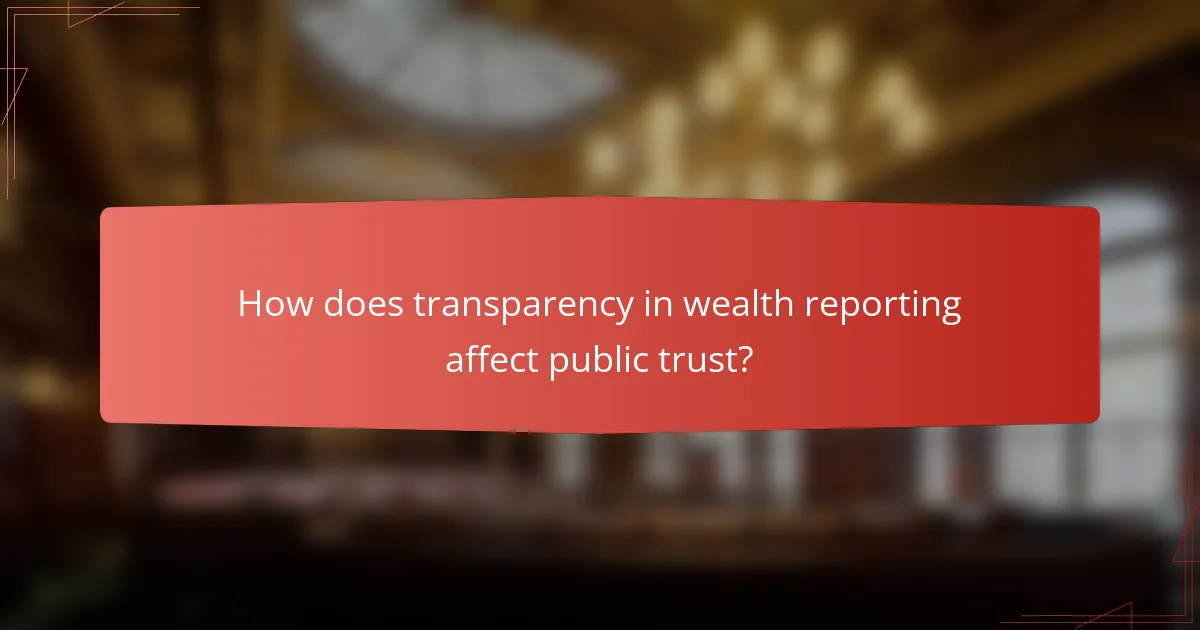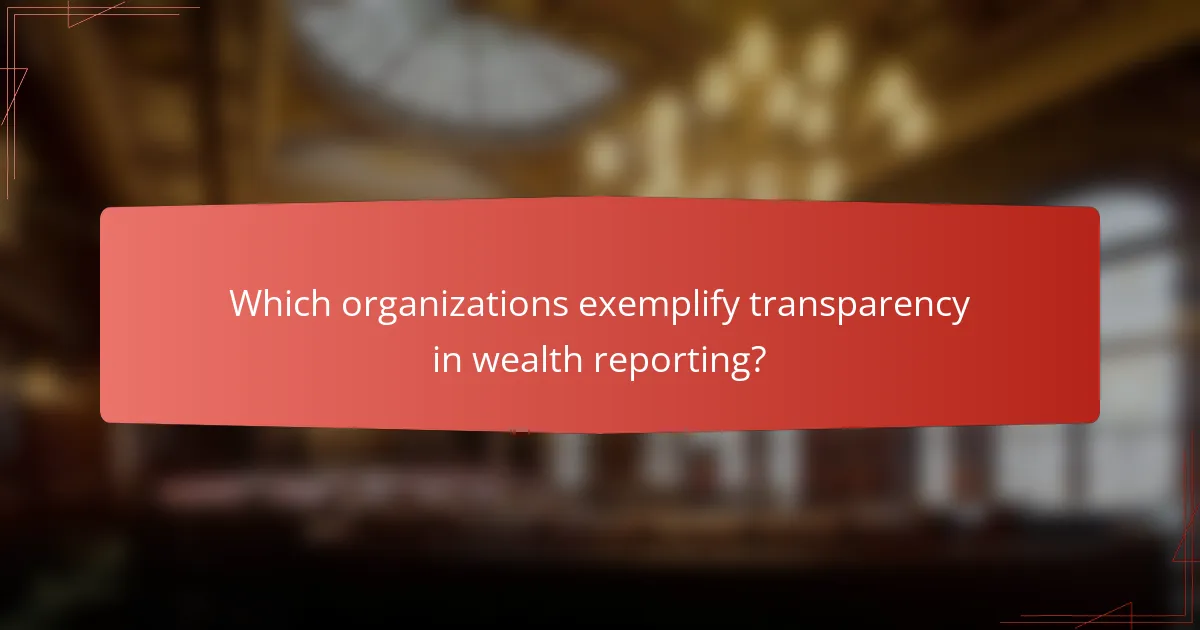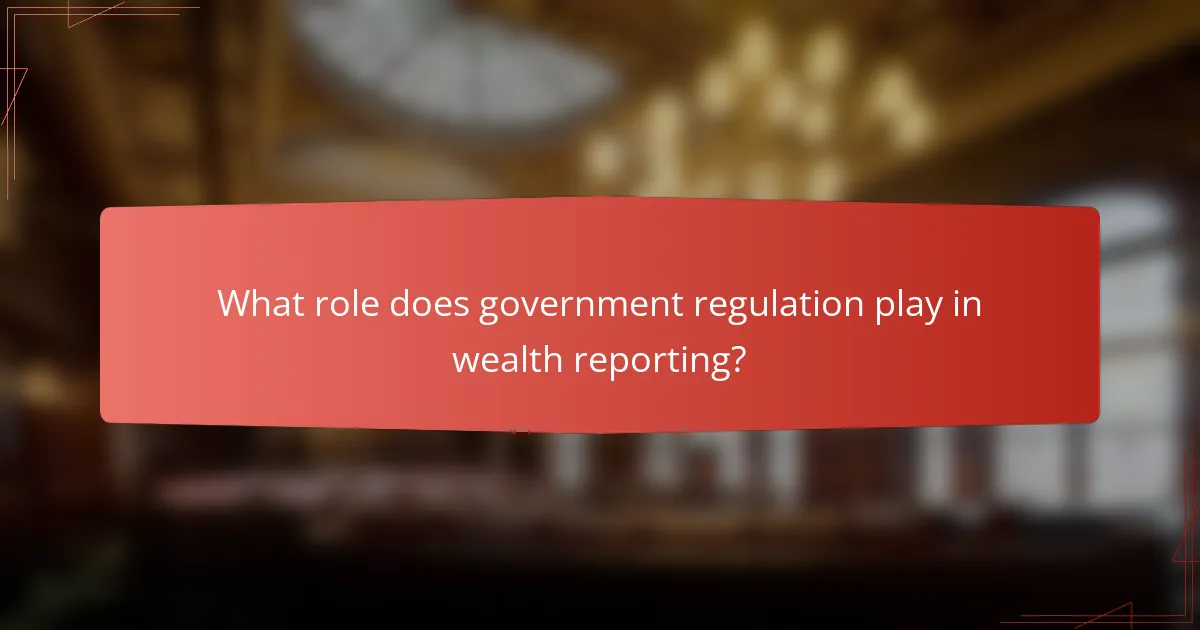Transparency in wealth reporting plays a crucial role in enhancing public trust by promoting openness and accountability. When individuals and organizations clearly disclose their financial information, it diminishes skepticism and fosters confidence among stakeholders. By adopting best practices such as regular disclosures and standardized reporting formats, entities can significantly bolster their credibility and strengthen public trust.

How does transparency in wealth reporting affect public trust?
Transparency in wealth reporting significantly boosts public trust by fostering a sense of openness and honesty. When individuals and organizations disclose their financial information clearly, it reduces skepticism and builds confidence among stakeholders.
Increased accountability
Transparency in wealth reporting leads to increased accountability as it holds individuals and organizations responsible for their financial actions. When wealth is openly reported, it becomes easier for the public to scrutinize financial decisions and practices.
This accountability can deter unethical behavior, as the fear of public exposure encourages compliance with regulations and ethical standards. For example, companies that regularly publish detailed financial reports are less likely to engage in fraudulent activities.
Enhanced credibility
Wealth reporting transparency enhances credibility by establishing trustworthiness among stakeholders. When financial data is readily available and accurate, it reassures the public that entities are operating with integrity.
Organizations that embrace transparency often see improved relationships with investors and customers. For instance, a company that openly shares its financial health is more likely to attract investment compared to one that keeps such information hidden.
Improved stakeholder engagement
Transparency in wealth reporting fosters improved stakeholder engagement by encouraging dialogue and participation. When stakeholders have access to clear financial information, they feel more empowered to voice their opinions and concerns.
This engagement can lead to more informed decision-making and collaborative efforts between organizations and their stakeholders. For example, community members who understand a company’s financial commitments are more likely to support its initiatives and projects.

What are the best practices for transparent wealth reporting?
Transparent wealth reporting involves clear and accessible methods for individuals and organizations to disclose their financial information. Best practices include regular disclosures, standardized reporting formats, and third-party audits to enhance credibility and public trust.
Regular disclosures
Regular disclosures are essential for maintaining transparency in wealth reporting. Organizations should establish a consistent schedule for reporting financial data, such as quarterly or annual updates, to keep stakeholders informed.
These disclosures should include key financial metrics, changes in asset values, and any significant financial events. Regular updates help build trust and allow the public to track financial performance over time.
Standardized reporting formats
Using standardized reporting formats ensures that financial information is presented in a clear and comparable manner. Adopting widely recognized frameworks, such as the International Financial Reporting Standards (IFRS), can facilitate understanding and analysis.
Standardization helps stakeholders easily interpret data across different entities, making it simpler to assess financial health and performance. Organizations should consider using templates that highlight essential information while minimizing complexity.
Third-party audits
Third-party audits provide an independent verification of reported financial information, enhancing credibility. Engaging reputable audit firms can help ensure that wealth reporting is accurate and complies with relevant regulations.
Regular audits can identify discrepancies and improve the reliability of financial disclosures. Organizations should prioritize transparency by making audit results publicly available, which can further strengthen public trust in their financial practices.

Which organizations exemplify transparency in wealth reporting?
Organizations that exemplify transparency in wealth reporting include those that provide clear, accessible information about financial activities and wealth distribution. These entities help build public trust by ensuring accountability and fostering informed decision-making.
Charity Navigator
Charity Navigator evaluates and rates charities based on their financial health, accountability, and transparency. By providing detailed reports on how donations are spent, it allows donors to make informed choices about where to contribute their money.
For example, Charity Navigator uses a star rating system, with a maximum of four stars, to indicate how well a charity meets its financial and operational standards. This clear rating helps potential donors quickly assess the reliability of a charity.
Transparency International
Transparency International is a global organization that focuses on combating corruption and promoting transparency in governance. It publishes the Corruption Perceptions Index, which ranks countries based on perceived levels of corruption in the public sector.
This index serves as a critical tool for understanding how transparency in wealth reporting can vary by country, influencing both public trust and investment decisions. Countries with higher transparency ratings often attract more foreign investment and public support.
OpenSecrets.org
OpenSecrets.org is a project of the Center for Responsive Politics that tracks money in U.S. politics and its effect on elections and public policy. It provides comprehensive data on campaign contributions, lobbying expenditures, and the financial interests of politicians.
This transparency allows citizens to see who is funding political campaigns and how that money influences legislative decisions. By making this information readily available, OpenSecrets.org empowers voters to hold elected officials accountable for their financial ties.

What challenges exist in achieving transparency?
Achieving transparency in wealth reporting faces several significant challenges that can undermine public trust. Key issues include data privacy concerns, regulatory compliance issues, and resistance from stakeholders, each of which can complicate efforts to provide clear and accessible financial information.
Data privacy concerns
Data privacy concerns are a major barrier to transparency in wealth reporting. Individuals and organizations often fear that disclosing financial information may expose them to identity theft, fraud, or unwanted scrutiny. This apprehension can lead to reluctance in sharing necessary data, ultimately hindering transparency efforts.
To address these concerns, organizations should implement robust data protection measures, such as encryption and anonymization, to safeguard sensitive information. Clear communication about how data will be used and protected can also help alleviate fears and encourage participation.
Regulatory compliance issues
Regulatory compliance issues can complicate transparency in wealth reporting. Different jurisdictions have varying laws regarding financial disclosure, which can create confusion and inconsistencies. Organizations must navigate these regulations carefully to avoid legal repercussions while striving for openness.
To manage compliance effectively, organizations should stay informed about relevant regulations, such as the General Data Protection Regulation (GDPR) in Europe or the Financial Accounting Standards Board (FASB) guidelines in the United States. Regular audits and consultations with legal experts can help ensure adherence to these standards.
Resistance from stakeholders
Resistance from stakeholders, including investors, executives, and employees, can pose a significant challenge to achieving transparency. Some may view transparency as a threat to competitive advantage or fear negative repercussions from revealing financial data.
Engaging stakeholders early in the process and demonstrating the benefits of transparency, such as enhanced trust and improved decision-making, can help mitigate resistance. Providing education on the importance of transparency in building public trust can also foster a more supportive environment.

How can technology improve wealth reporting transparency?
Technology can significantly enhance wealth reporting transparency by providing secure, accurate, and timely information. Tools like blockchain, artificial intelligence, and real-time reporting systems enable stakeholders to access reliable data, fostering greater trust in financial disclosures.
Blockchain for secure records
Blockchain technology offers a decentralized and immutable ledger for wealth reporting, ensuring that records are secure and tamper-proof. Each transaction is recorded in a way that is transparent and verifiable, which can help prevent fraud and misrepresentation.
For example, using blockchain, financial institutions can provide real-time access to asset ownership and transaction history, allowing stakeholders to trace the origins of wealth. This level of transparency can enhance public trust, as users can independently verify information without relying solely on third-party assurances.
AI for data analysis
Artificial intelligence can process vast amounts of financial data quickly, identifying patterns and anomalies that may indicate discrepancies in wealth reporting. By employing machine learning algorithms, organizations can enhance the accuracy of their reports and detect potential issues before they escalate.
AI tools can also automate the analysis of compliance with regulations, ensuring that wealth disclosures meet legal standards. This proactive approach not only improves transparency but also reduces the risk of penalties associated with non-compliance.
Real-time reporting tools
Real-time reporting tools enable organizations to provide up-to-date information on wealth and asset management. These tools can integrate with various data sources, allowing for immediate updates that reflect current market conditions and asset valuations.
For instance, financial apps that offer real-time insights into portfolio performance can help users make informed decisions based on the latest data. This immediacy fosters a culture of transparency, as stakeholders can see changes as they happen, rather than relying on periodic reports that may become outdated quickly.

What role does government regulation play in wealth reporting?
Government regulation is crucial in wealth reporting as it establishes the framework for transparency and accountability. These regulations ensure that individuals and organizations disclose their financial information accurately, which can enhance public trust in economic systems.
Mandatory disclosure laws
Mandatory disclosure laws require individuals and corporations to report their wealth and financial activities to relevant authorities. These laws aim to prevent tax evasion, money laundering, and other financial crimes by promoting transparency.
In many countries, such as the United States and those in the European Union, these laws dictate specific thresholds for reporting income, assets, and liabilities. For example, individuals may need to report any income exceeding a certain amount, while corporations must disclose significant financial transactions to regulatory bodies.
Compliance with these laws can vary by region, with some jurisdictions imposing strict penalties for non-compliance. Individuals and businesses should be aware of their local regulations to avoid legal repercussions and maintain public trust.



